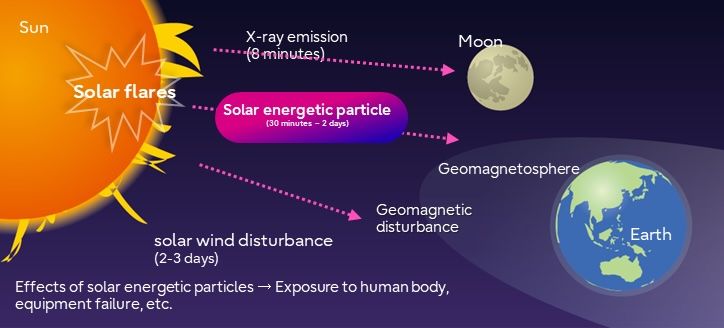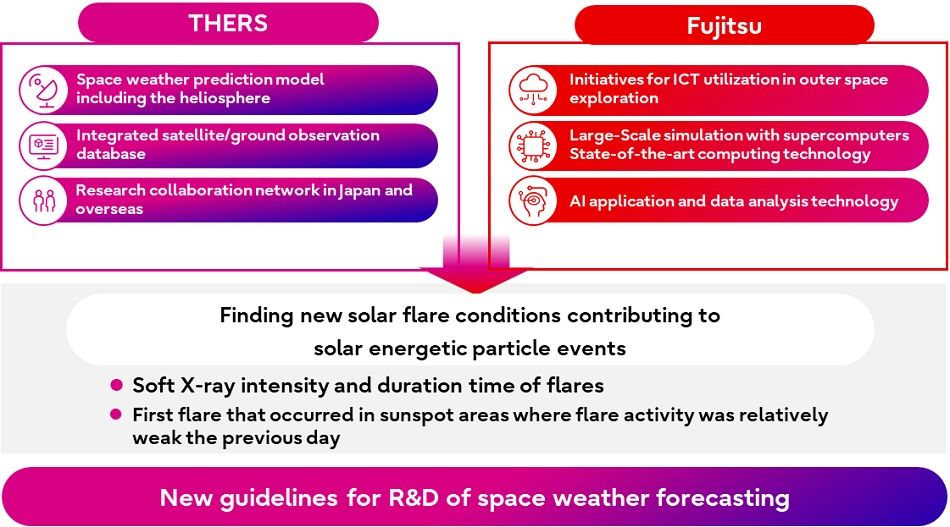
TOKYO, Mar 14, 2024 – (JCN Newswire via SeaPRwire.com) – Fujitsu and Tokai National Higher Education and Research System (hereinafter THERS) today announced a joint research on the prediction of space radiation phenomena to ensure the safe human exploration of the Moon, Mars, and interplanetary space (1). As part of the joint research, the two partners applied Fujitsu’s “Wide Learning” explainable AI technology offered via Fujitsu’s AI platform Kozuchi, and discovered conditions for the occurrence of solar flares (2), solar eruptive events which lead to an increase in solar energetic particles (hereinafter SEP) (3) which in turn affect space weather.
Moving forward, Fujitsu and THERS will continue to accelerate research to further enhance space weather forecasts and support the exploration of outer space.
Fujitsu and THERS presented results of this joint research at the 2024 Annual Spring Meeting of the Astronomical Society of Japan, to be held on Monday, March 11, 2024.
Background
Based on a partnership agreement between Fujitsu and THERS signed on February 24, 2023 (4), Fujitsu and Nagoya University’s Institute for Space-Earth Environmental Research (hereinafter ISEE) (5), an affiliate organization of THERS, have been conducting joint research on the advancement of space weather forecasts to solve challenges related to human exploration of outer space.
Space weather not only impacts our activity in space, but can also cause communication failures in daily life, disturbances in satellite positioning, and affect air route planning. Research on space weather observation represents an increasingly important challenge both in Japan and globally.
SEPs, a type of cosmic ray (6) that is formed suddenly and propagates through space following flares and coronal mass ejections (7) directly affect objects such as satellites, but also human bodies and astronauts. Direct exposure to SEPs in space can lead to lethal doses.

To derive the conditions for the occurrence of flares that lead to an increase in SEPs, Fujitsu and THERS leveraged Fujitsu’s “Wide Learning” explainable AI technology to analyze and extract the conditions that lead to the occurrence of these SEP events from a large number of combinations of data on factors including flare brightness, occurrence position, and duration.
Data used in the researchDatabase of past SEP events and soft X-ray intensity, longitude, and flare duration time provided by the National Oceanic and Atmospheric Administration’s (NOAA) Space Weather Prediction CenterSolar photospheric magnetic field data in the area around sunspots observed by the National Aeronautics and Space Administration (NASA) Solar Dynamics Observatory satellite (8)A 3D magnetic field model around sunspots (9) calculated by the Fujitsu supercomputer “Flow” installed by the Information Technology Center, Nagoya University in 2020, using a scheme developed by ISEE
As a result of their research, Fujitsu and THERS found that the soft X-ray intensity and duration time of flares represent an important factor in the generation of SEP events, and that the first flare generated in sunspot regions with a low number of flares is likely to cause an increase in SEPs.
As flares tend to occur continuously at certain sunspots, common methods to predict flare occurrence referred to history data of the last flare. However, Fujitsu and THER’s research results suggest that the prediction of the first flare, which occurs in the sunspot region where the flare activity of the previous day was relatively weak, represents an important factor in the prediction of SEP events, providing a new guideline for the future research and development of space weather forecasts.Fujitsu and THERS confirmed that the numerical model constructed within their joint research enables prediction of the increase of SEP with the same accuracy as conventional prediction methods, and that accuracy can be further improved by using original parameters based on the three-dimensional magnetic field model around sunspots.

Future Plans
To contribute to the realization of safe human exploration of outer space, Fujitsu and THERS will continue to analyze the prediction of first solar flares as an important factor in SEP events, accelerate research to provide new findings related to the generation of SEP events, and combine THERS’ knowledge in the field of space science with Fujitsu’s technology to engage in R&D and social implementation of space weather forecasting.
[1]Interplanetary space :Space between planets in the solar system
[2]Solar flares :Large explosions in the Sun’s atmosphere
[3]Solar energetic particles :(Proton event.) The occurrence of accelerated energetic particles associated with solar flares and coronal mass ejections
[4]“Fujitsu and Tokai National Higher Education and Research System sign partnership to create wellbeing society and develop space technologies, contribute to the achievement of the SDGs and Society 5.0” (press release, February 24, 2023)
[5]Institute for Space-Earth Environmental Research :Director: Kazuo Shiokawa
[6]Cosmic ray :Various types of radiation present in outer space
[7]Coronal mass ejection :A sudden and massive ejection of plasma from the solar corona into interplanetary space
[8]Solar Dynamics Observatory :Solar Dynamics Observatory Mission
[9]3D magnetic field model around sunspots :Kusano et al. 2020 Science
About Fujitsu
Fujitsu’s purpose is to make the world more sustainable by building trust in society through innovation. As the digital transformation partner of choice for customers in over 100 countries, our 124,000 employees work to resolve some of the greatest challenges facing humanity. Our range of services and solutions draw on five key technologies: Computing, Networks, AI, Data & Security, and Converging Technologies, which we bring together to deliver sustainability transformation. Fujitsu Limited (TSE:6702) reported consolidated revenues of 3.7 trillion yen (US$28 billion) for the fiscal year ended March 31, 2023 and remains the top digital services company in Japan by market share. Find out more: www.fujitsu.com.
Press Contacts
Fujitsu Limited
Public and Investor Relations Division
Inquiries
Copyright 2024 JCN Newswire via SeaPRwire.com.